Exploring an Abandoned L1011 TriStar on a Beach in West Africa
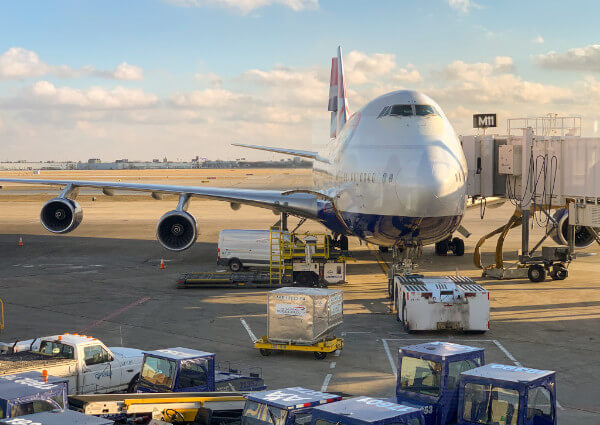
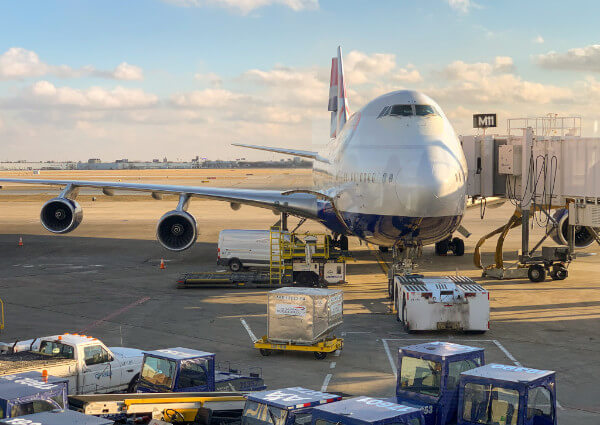
What a view! Could you imagine just seeing an L1011 on the beach? – Photo: Jerome de Vries
I was recently in Cotonou for a 24-hour layover. Cotonou is the largest city of the small west African nation of Benin, and has become a secondary hub for emerging airline RwandAir. Taking advantage of its growing network, I booked a RwandAir ticket from Dakar, Senegal to Kigali, Rwanda via Cotonou. The transit stop included accommodation provided by the airline.
What is there to do in Cotonou? A quick Google search indicated that the closest attraction to the hotel was on the beach: an ‘amusement parkâ€
called Air de Jeux Plage Erévan. This ‘park’ appeared to include a large-looking aircraft, so I decided to check it out. Little did I know the airframe was a historic Lockheed L1011 TriStar, full of amazing clues about its long and varied history around the world.

Mystery plane? – Image: Google Maps
Cotonou appeared relatively relaxed compared to my previous destination of Dakar. The streets were quiet and the buildings were relatively low-rise. The beach was a wide expanse of sand, far cleaner than expected, with an ocean that is uninterrupted all the way to Antarctica. It was there that the ‘amusement parkâ€
came into sight, and as I went closer the aircraft became clear: a white-washed Lockheed L1011 TriStar.
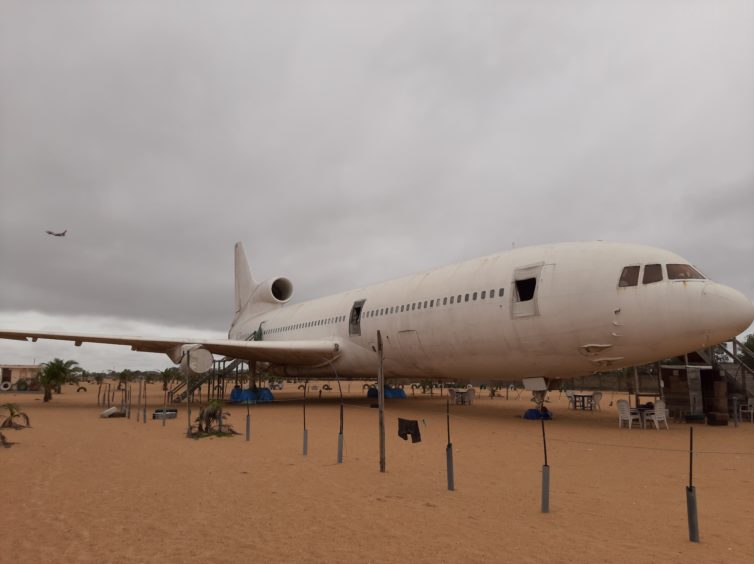
Could you imagine walking down the beach and seeing a Tristar just sitting there? Pretty awesome – Photo: Jerome de Vries
What a remarkable sight. I had always been interested in the TriStar. Perhaps for its iconic S-duct which feeds the tail engine. Perhaps because it was Lockheedâ€
s last civilian aircraft. Perhaps because the various grounded TriStars I have seen in airports around the world. Today there is only one still operating, N140SC, which is dubbed the ‘stargazerâ€
and is used as a flying rocket launcher for Northrop Grumman.
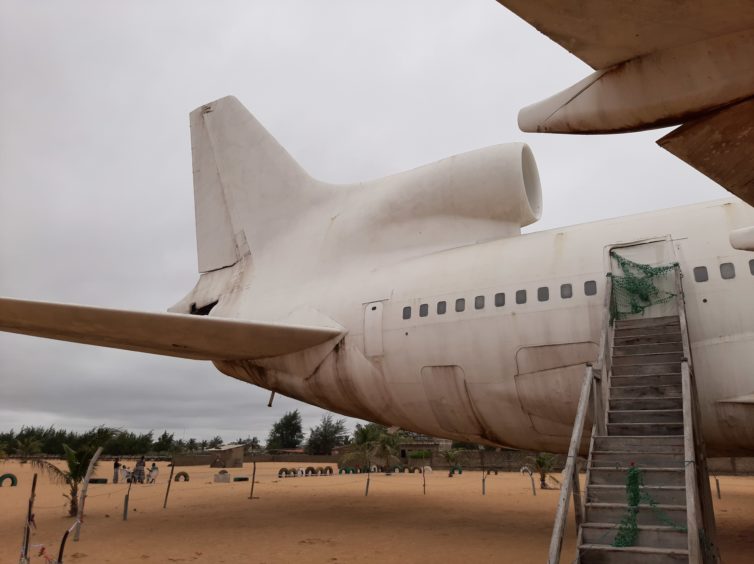
Photo: Jerome de Vries
The airframe appeared to be in a decent condition, though its engines had been stripped and markings on the fuselage had been painted over. I assumed it would therefore be difficult to uncover the aircraftâ€
s registration and ownership history. The removal of the rear engine provided a unique opportunity to view the S-duct in its entirety.
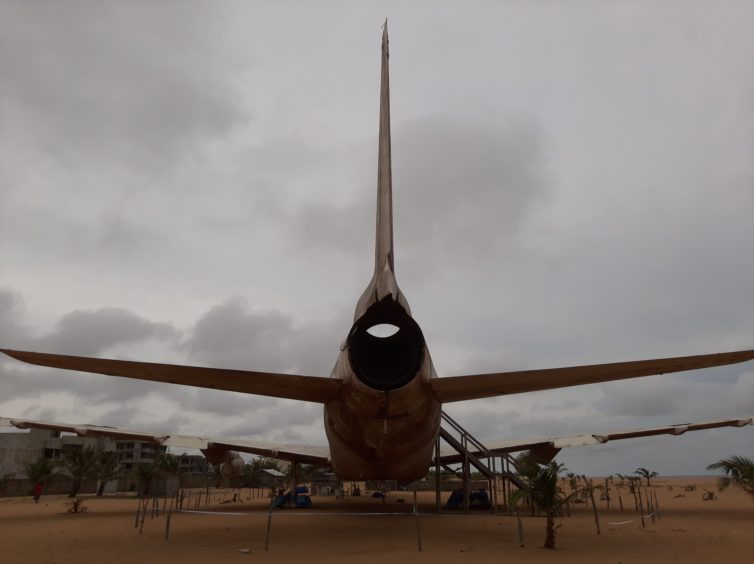
Seeing through the S-duct is a unique viewpoint – Photo: Jerome de Vries
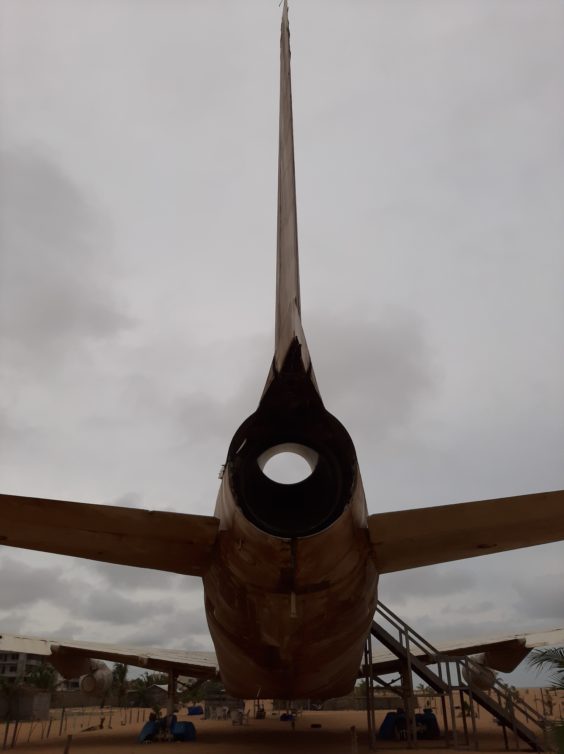
Photo: Jerome de Vries
Some chairs and tables were scuttled around the aircraft, and a wooden staircase was clumsily constructed up to the forward left door. A man sat leisurely next to the staircase, clearly less excited about the aircraft than I was. He started speaking French, but could move to English easily enough. “Go inside, 2000 Francsâ€. About $3.30 USD — deal!
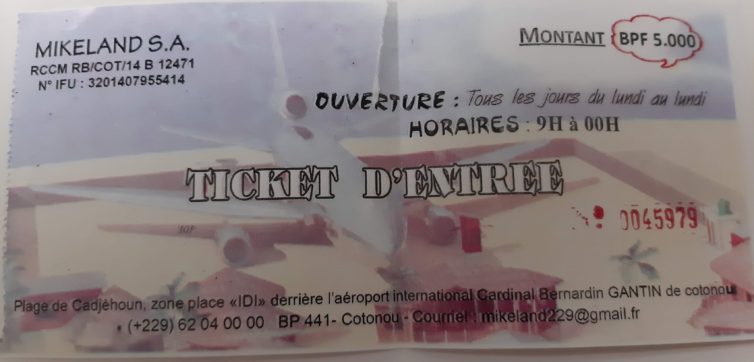
The ticket quotes a price of 5,000 West African Francs – I must have received a discount! – Photo: Jerome de Vries
I was very happy to hand over the necessary West African cash. I started to make some inquiries about the aircraft. “TriStar,†he said. “L1011.†“Sierra Leone. Kambuja. Owner want to make into restaurant.†I wasnâ€
t sure what “Kambuja†meant, but was soon to find out.
Iâ€
ve seen images of abandoned aircraft around the world, including the Boeing 747 parked on private property in Bangkok. In many cases, the aircraft have their insides thoroughly stripped and show little indication of their previous owners. Flight decks often have their instruments ripped out, and I expected the same for this TriStar. However, I was to be in for an incredible surprise.
The first thing that grabbed my attention upon entering was a bronze plaque posted next to the forward door. The registration number, serial number and ownerâ€
s details were all meticulously detailed. The aircraft bore Sierra Leonian registration 9L-LFB, and last operated for Air Rum. So much for any trouble working out the aircraftâ€
s history.
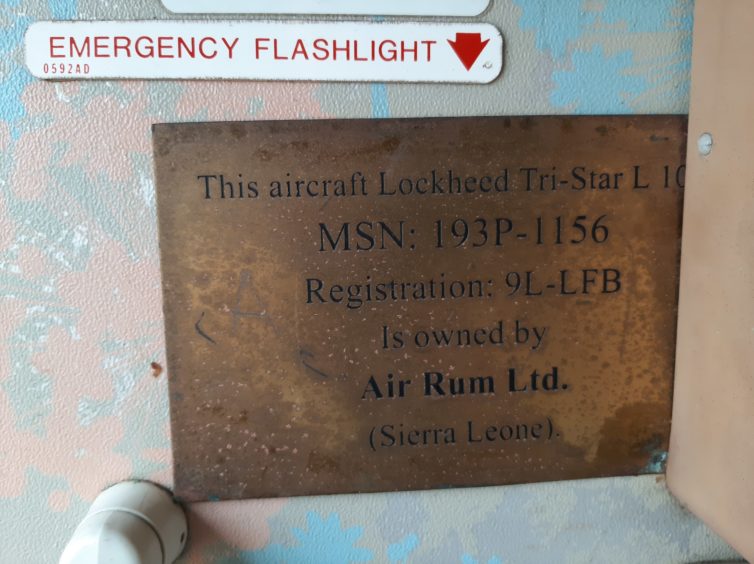
Photo: Jerome de Vries
I had heard of Air Rumâ€
s TriStar operations before. They were a Jordanian-owned charter operator in the mid-2000s that operated a fleet of five TriStars. The airline was in the headlines in 2005 for faking a fuel emergency in Peru. The captains allegedly did this to land at an airport that better suited the Gambian football fans on board. The airline was also banned from operating in the European Union. The below screenshots from their former website (recovered using the Internet Archive) donâ€
t inspire much confidence.
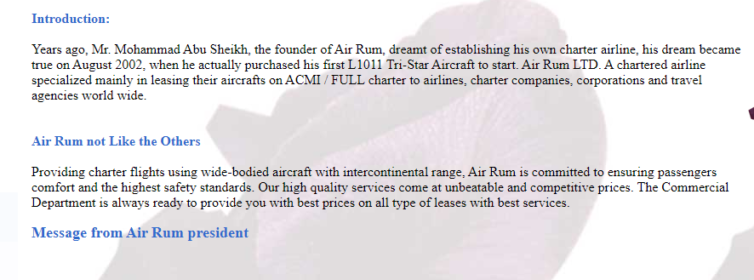
Image: Air Rum (Accessed via Internet Archive)
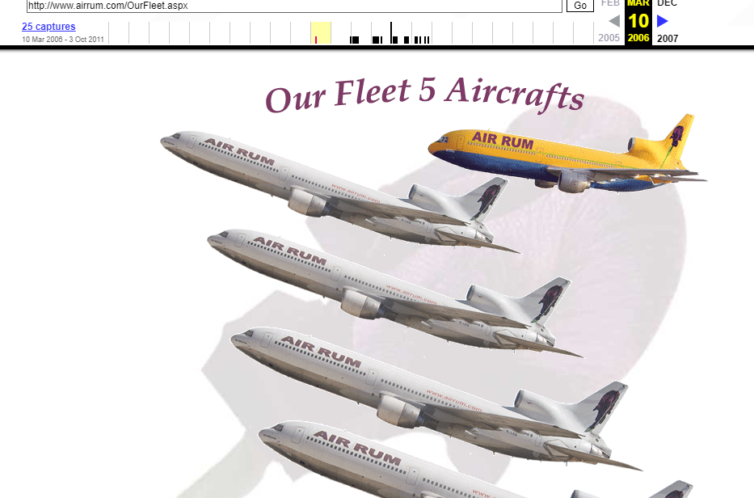
Image: Air Rum (Accessed via Internet Archive)
The manufacturerâ€
s plate in the doorway indicated the aircraft began its life in Burbank, California on the 8th of August 1978. Who knew that 41 years later it would rest here, on the beaches of West Africa?
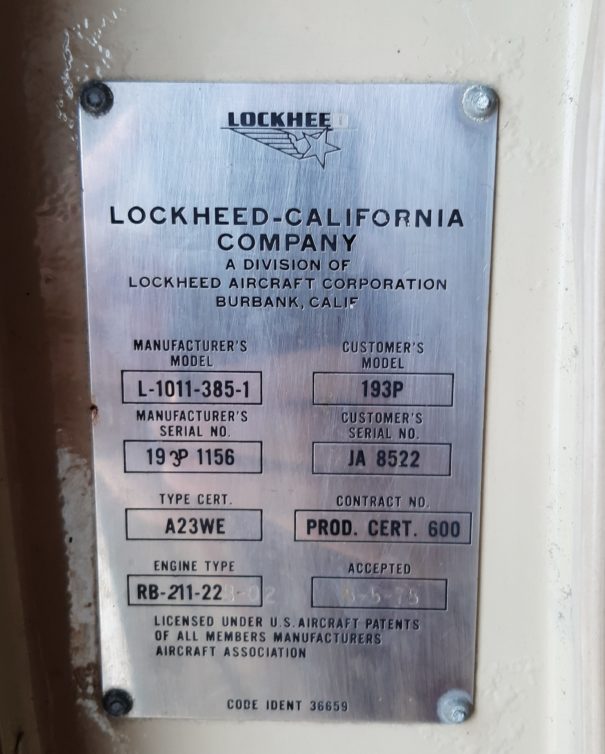
Photo: Jerome de Vries
The aircraft had a long and varied operational history. It started in Japan with All Nippon Airlines (ANA) as JA8522. ANA operated it for 18 years before it was sold to US-based Rich International Airways in 1996, tail number N309GB. In 2001 the TriStar was moved to southeast Asia where it operated for Kampuchea Airlines of Cambodia as XU-100. Kampuchea Airlines was partly owned by Orient Thai who also operated the aircraft. The TriStar was finally purchased by Air Rum in 2004, who named it “Barakah.” Air Rum collapsed in 2008 and left its fleet of six TriStars at various airports, including this one in Cotonou where it had been conducting hajj charters for a Cameroonian company.
“Barakah” sat in a corner of Cotonou airport until 2015 when a local businessman bought it and towed it 400 meters across the road to the beach. The plan is to make the aircraft into a restaurant, a similar fate to other preserved aircraft around the world. Four years later, there hasnâ€
t been much progress on the project apart from the removal of the engines and the whitewashing of the fuselage. There was decay in the cabin as the doors were left open, exposing everything to the rain and sea air.
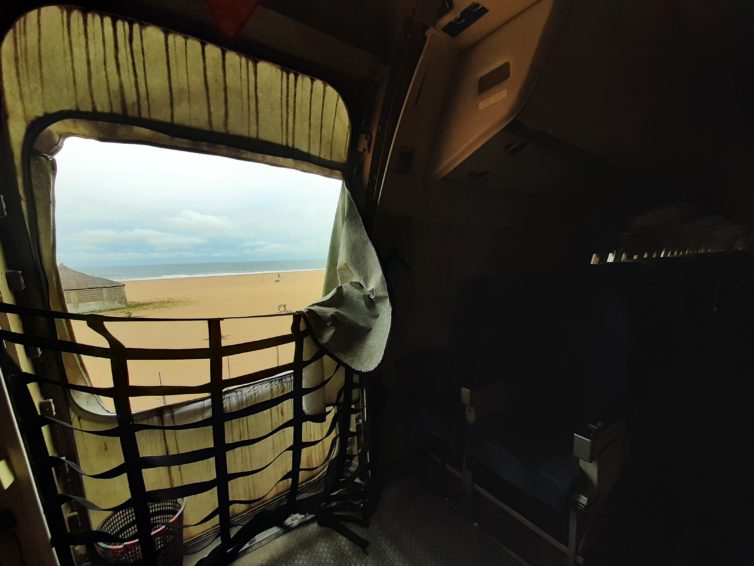
An Lockheed L1011 with a view – Photo: Jerome de Vries
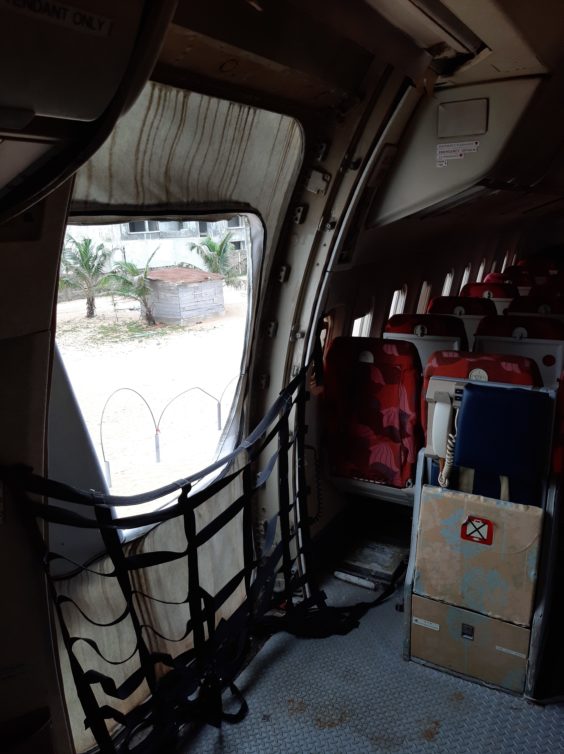
Photo: Jerome de Vries
The cabin was only configured in economy class, unusual for a widebody, and had a 3-4-2 layout. This must have made it more comfortable than the famously unpopular 2-5-2 layout that some carriers opted for. The lack of overhead bins above the middle seats created a spacious feeling in the cabin. Japanese signage clearly indicated the 18 years of operation by ANA, including on the galley lifts.
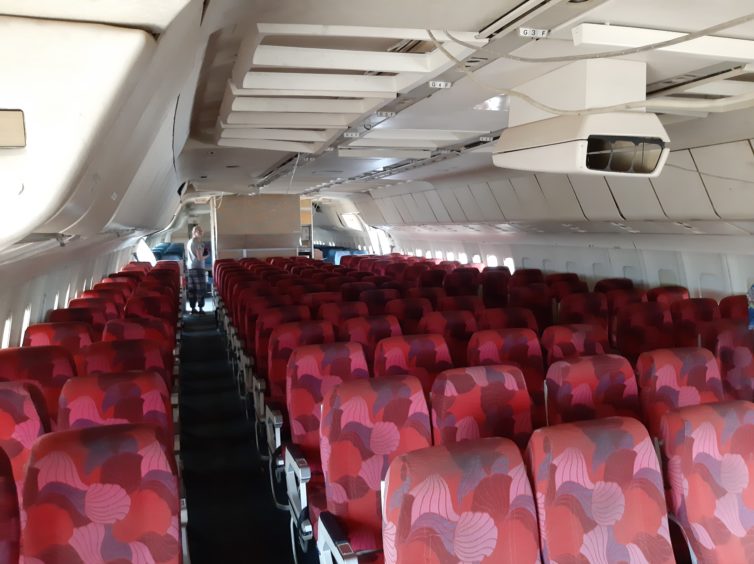
The L1011’s economy interior is still in pretty good shape, although the projector is missing – Photo: Jerome de Vries
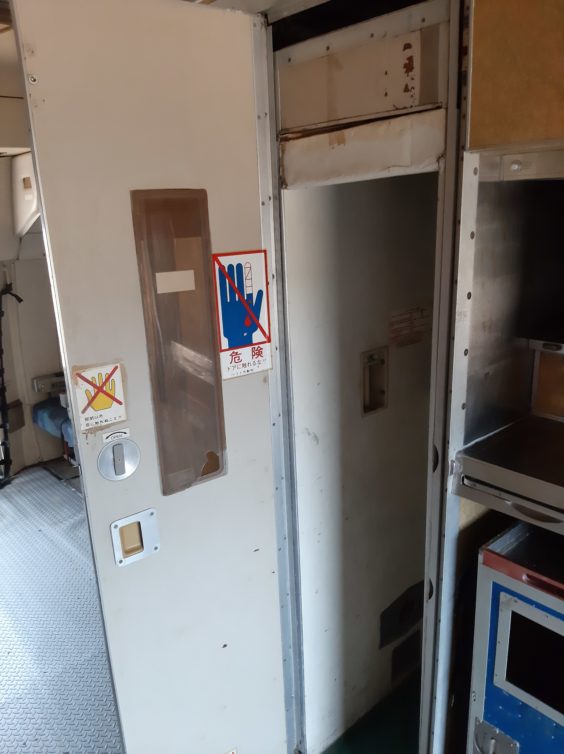
Catering lift with some fairly intense warnings… | Photo: Jerome de Vries
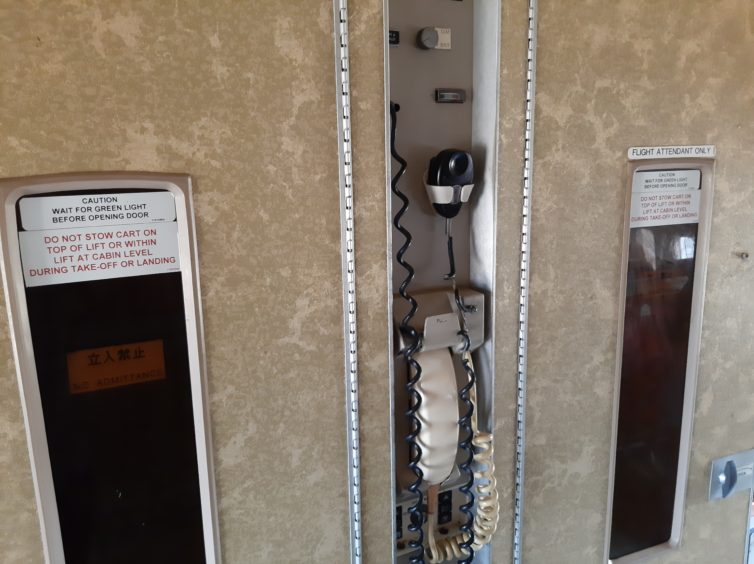
Photo: Jerome de Vries
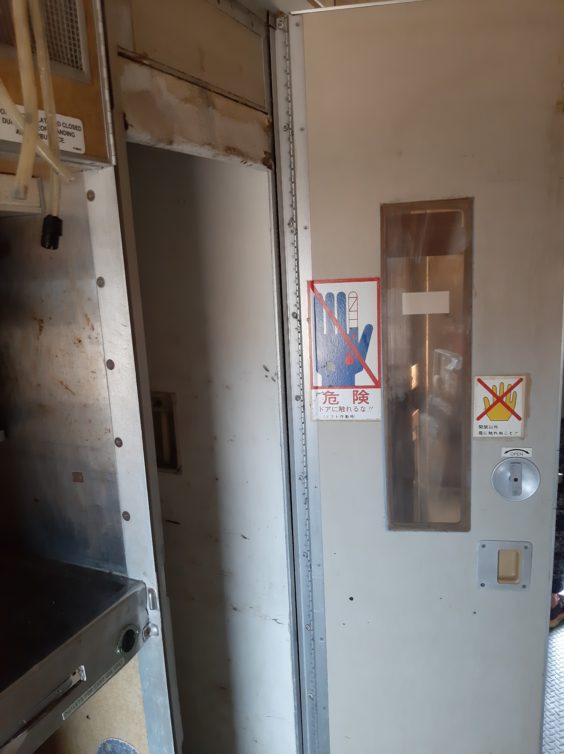
Photo: Jerome de Vries
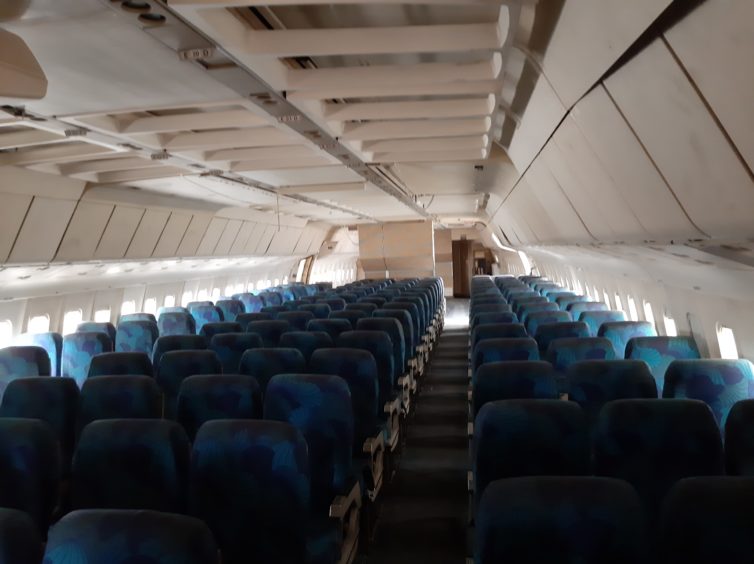
Photo: Jerome de Vries
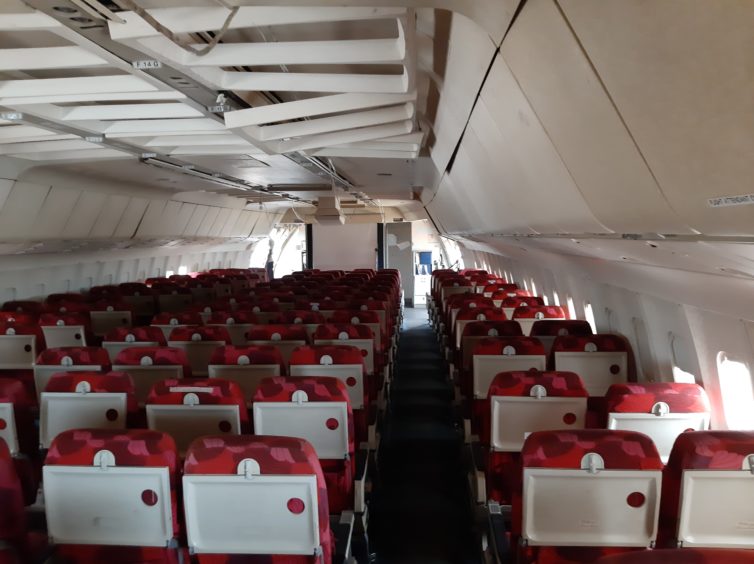
Photo: Jerome de Vries
The meal carts represented the short period of ownership by Kampuchea Airlines.
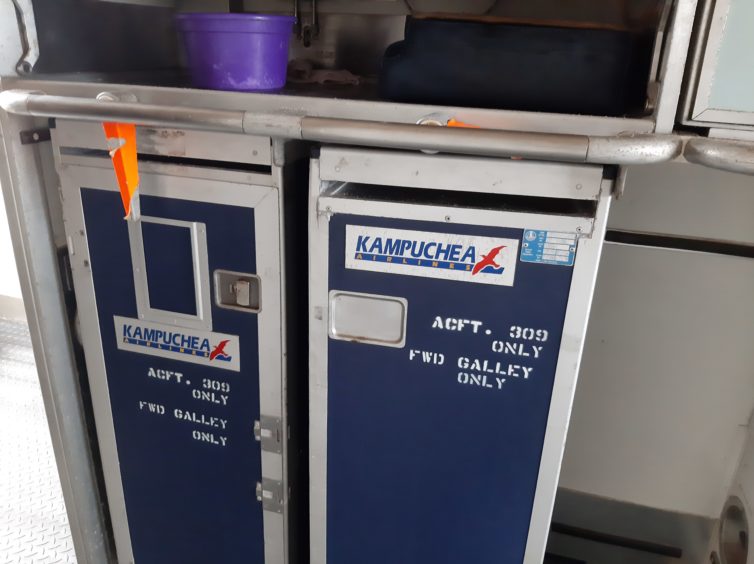
The carts show one of the previous owners of the aircraft — Kampuchea Airlines – Photo: Jerome de Vries
“Kambujaâ€, the ticket seller proclaimed as I photographed the meal carts. I suddenly understood what he was referring to.
“Oui, Kampuchea, Cambodiaâ€, I responded.
“Ahh! Cambodge! Near Thailand!â€, the man exclaimed. He seemed pleased with this information, his knowledge of the far-away nation perhaps aided by the fact that both Benin and Cambodia were once French colonies.
“Also Japan and America!â€Â I added, hoping the information would assist future tours he gives of this historic airframe.
Like the cabin, the spacious cockpit was in a good condition considering the ceiling escape hatch was hanging open. The instruments were largely in place, and it was impressive to see the complexity of the engineerâ€
s panel. Scrawled in marker pen above some instruments were the words “Orient operations ex-BKKâ€, a hint of the aircraftâ€
s former life at Don Mueang airport in Bangkok.
It appears that Don Mueang was one of the last major harbors of the TriStar, as now-defunct Thai Sky Airlines operated two TriStars from the airport in the mid-2000s. One of them (formerly HS-AXE) has been moved to a Bangkok market where it now serves as – you guessed it – a restaurant.
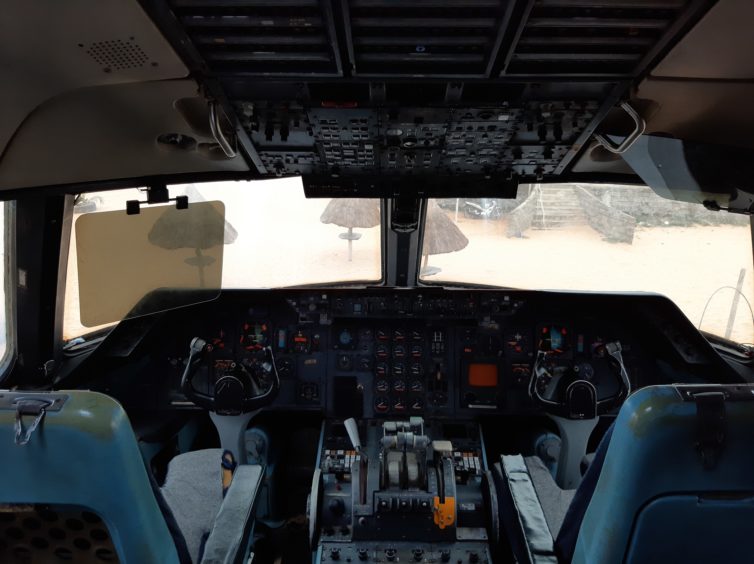
Surprisingly, the flight deck of the L1011 was in pretty good shape – Photo: Jerome de Vries
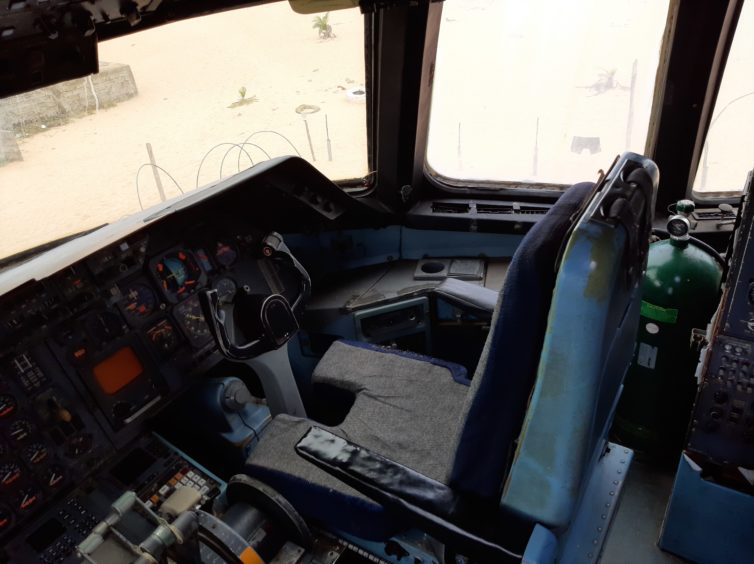
Photo: Jerome de Vries
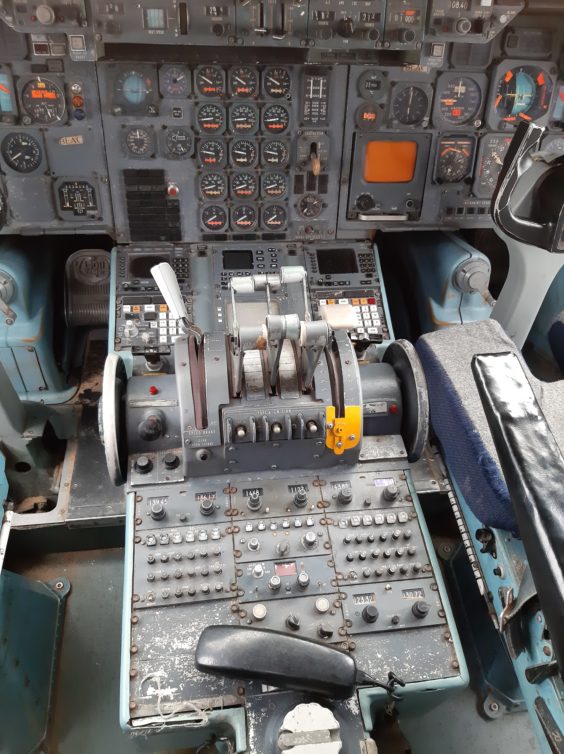
Photo: Jerome de Vries
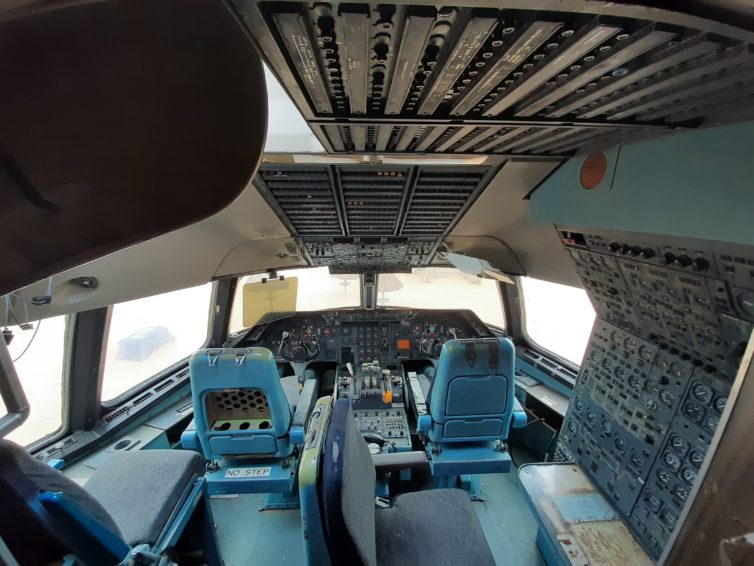
Photo: Jerome de Vries
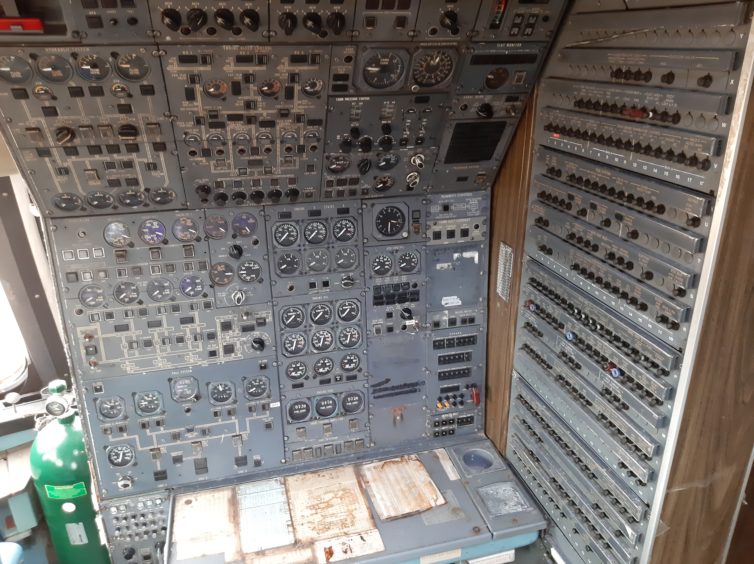
The engineer’s station inside the L1011 flight deck – Photo: Jerome de Vries
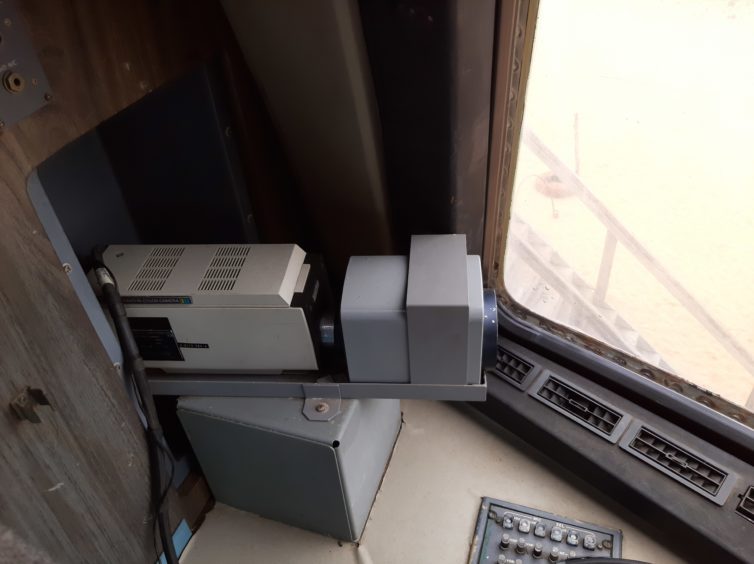
This camera was sitting by the left-hand window. Was it a normal feature of the TriStar cockpit? | Photo: Jerome de Vries
It was an incredible privilege to find this old TriStar and be free to explore its historic interior. The aircraftâ€
s fate is unknown – plans to convert into a restaurant are clearly not progressing fast, and it is well exposed to the elements. The ticket seller was amused by my enthusiasm for the aircraft. Maybe preserving “Barakah” in her current state isnâ€
t such a bad idea – who knows, there may one day be hordes of TriStar enthusiasts travelling to Benin to have a look.
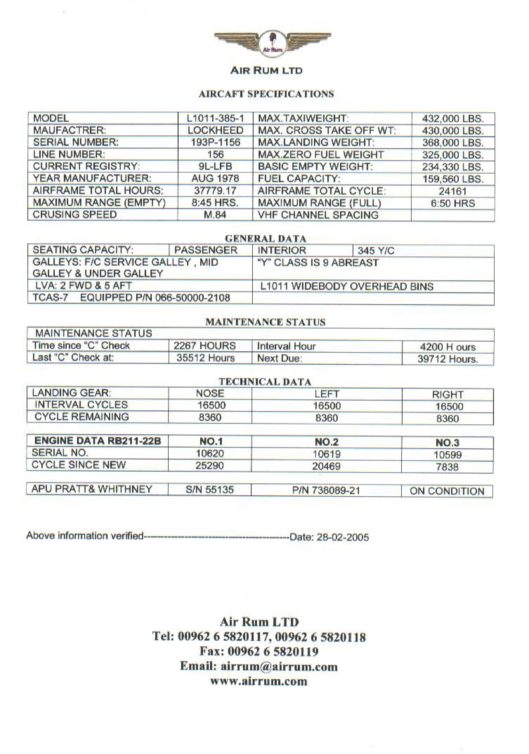
Image: Air Rum (Accessed via Internet Archive)
This story was written by Jerome de Vries from Wellington, New Zealand. When he isn’t working as a lawyer, heâ€
s often thinking about where to travel next and what the most interesting way to get there would be.
This story was originally published in March 2020 and republished in May 2021.Â
The post Exploring an Abandoned L1011 TriStar on a Beach in West Africa appeared first on AirlineReporter.





